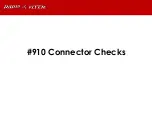
14
8. Trouble-shooting
Frequently encountered problems and their solutions:
- Steering arm is by mistake attracted by a permanent magnet: the permanent magnet is too close to the wire/magnetic tape.
- Vehicle does not follow bends: arm too far from road surface, possibly tyres are dirty, worn or the steering is dirty.
- Vehicles collide: IR Adaptive Cruise Control is turned off or too much sunlight from the front is blinding the vehicles.
- Warning lights are activated and the vehicle is very slow: this is the signal for low battery. Please recharge the batteries.
9. Environmentally friendly disposal
Do not dispose of this product through (unsorted) domestic waste, supply it to recycling instead.
The symbol of the crossed-out wheeled bin on batteries or accumulators indicates that they must not be disposed of with
household waste. If batteries or accumulators contain mercury (Hg), cadmium (Cd) or lead (Pb), you will find the respective
chemical symbol underneath the symbol of the crossed out dustbin. You are legally obliged to return old batteries and
accumulators after use. You can do so free of charge at a retail outlet or at another collection point in your vicinity. You can
obtain addresses of suitable collection points from your city or local authority.
Batteries may contain substances that are hazardous for the environment and the human health. Special caution is required
when handling batteries containing lithium due to the particular risks involved. The separate collection and recycling of old
batteries and accumulators are keyed to avoiding a negative impact on both environment and human health.
Please avoid the generation of waste from old batteries as far as possible, e. g. by using batteries with a longer life or
rechargeable batteries. Please avoid littering the public space by not carelessly leaving batteries or electrical and electronic
equipment containing batteries lying around. Please check and consider ways of reusing a battery instead of disposing of it,
e. g. by reconditioning or repairing it.
Further information on the battery law can be found on the internet at www.batteriegesetz.de.
10. Technical data
10.1 Power supply
The included charger, item 8400 has a micro USB connection and may be connected to any PC, laptop, phone or tablet
charger, provided the correct cable is being used.
10.2 Li-Po batteries
The vehicle is equipped with 2 pouch cell Li-Po batteries, each having a capacity of 60 mAh. Both batteries are equipped
with protection modules that prevent the user from overcharging, deep discharging and short circuiting them. The batteries
are also rated for high safety and will not catch fire even if they are punctured or pierced.
10.2.1 Service life of pouch Li-Po batteries
All rechargeable batteries unfortunately have a property in common: their service life is limited. The service life of recharge-
able batteries is measured using the number of complete charging cycles, that is, the total number of charging procedures
that are possible. It is estimated that the capacity of these batteries will drop to 60% of their original after a minimum of 1000
complete (empty to fully charged) cycles of use.
Preferred operation: The batteries may be charged at any state of charge and for any short period of time needed. On average, the
vehicle is designed to operate about twice as long as it is charged. This way the batteries will have the longest lifespan.
Memory Effect: There is no memory effect when charging Li-Po batteries.
Self-discharge: Rechargeable batteries are prone to self-discharge over time. This means that they lose part of their stored
energy even if the vehicle is not switched on at all. At worst, a rechargeable battery may even be subject to deep self-
discharge, a state in which the materials inside the battery start to degrade. You should therefore charge your vehicles every
six to twelve months for at least a couple of minutes, even if you do not use them.
Storage: When for some reason it is known that the vehicle will not be used for a prolonged period of time, it is recommended
to leave at least 25% (though 60% is preferred) of charge in the batteries before retiring the vehicle. It is also recommended
not to retire vehicles that are 100% charged. In such a case it is recommended that the vehicles be turned on for about 20
minutes so that the batteries will discharge to a value that is closer to the recommended 60% storage capacity. The user
may check the state of charge of the batteries either by observing the blinking pattern of the cabin LED during charging, or
by using the CarManager software (chapter 6).
Subject to change without prior notice. No liability for
mistakes and printing errors.
You will find the latest version of the manual on the Viess-
mann website using the item number.
Do not dispose of this product through (un-
sorted) domestic waste, supply it to recycling
instead.





































